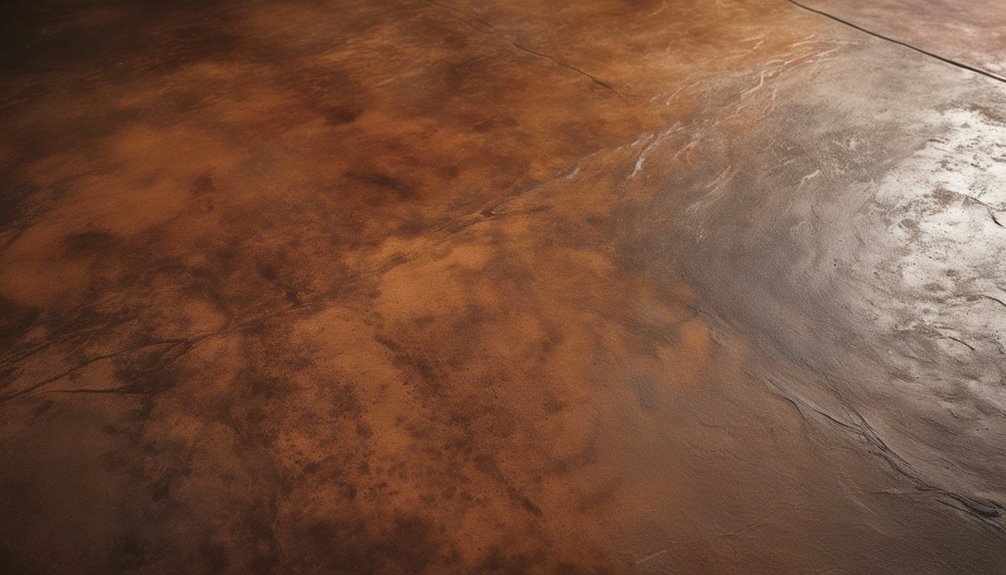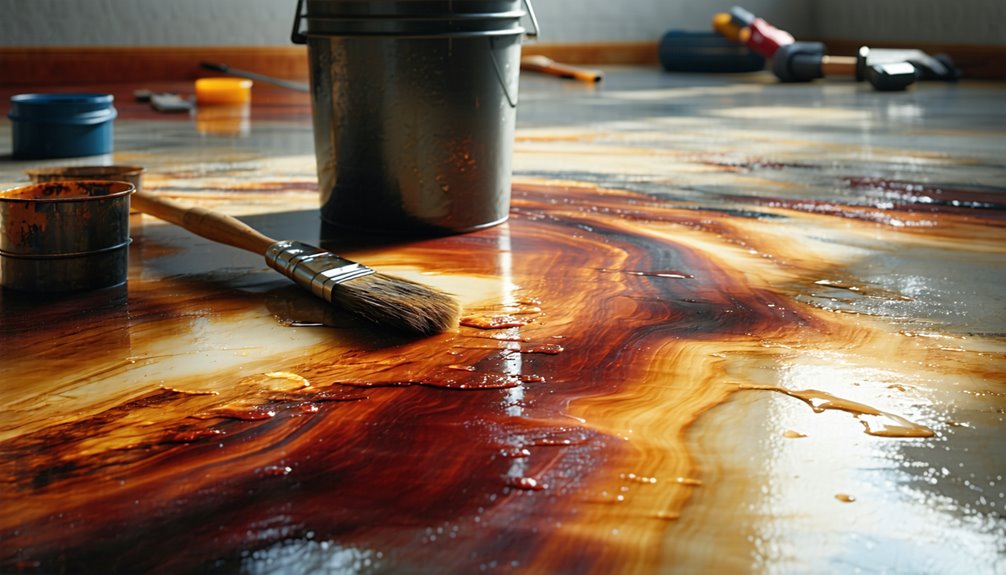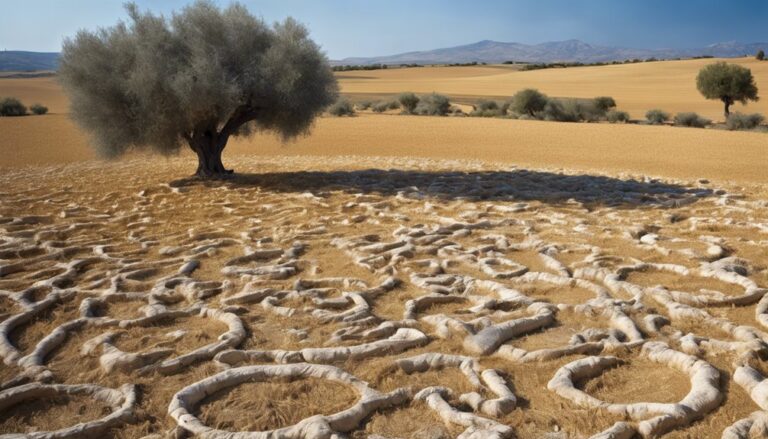To stain concrete floors, first gather your supplies, including your chosen stain type and protective gear. Clean the surface thoroughly to guarantee adhesion, and repair any cracks. Test moisture levels; it should be below 4%. Once dry, apply the stain using a sprayer or roller, working in sections to maintain wet edges. Follow the manufacturer's instructions on drying time, and consider layering for depth. Finally, seal the surface to enhance durability and maintain its vibrancy. With the right techniques, you can achieve stunning results, and further insights can help refine your project beyond the basics.
Gather Your Supplies

Before you plunge into staining your concrete floors, you'll need to gather a few essential supplies to guarantee the process goes smoothly. Start by choosing your stain types; water-based and acid-based are the most common. Each offers different finishes and durability, so consider your needs. Next, select your colors wisely—darker shades can hide imperfections, while lighter hues can make spaces feel larger. Grab a paint roller or a sprayer for application, along with brushes for edges and detailed work. You'll also need protective gear like gloves and goggles, as well as drop cloths to protect surrounding areas. Finally, don't forget a concrete cleaner to prepare the surface before staining, ensuring the best adhesion and finish for your project.
Prepare the Concrete Surface
Before staining, you need to prepare the concrete surface properly. Start by cleaning it thoroughly to remove dirt, grease, and any contaminants. Then, repair any cracks and test for moisture levels to guarantee ideal adhesion of the stain.
Clean the Surface Thoroughly
A clean surface is essential for achieving a successful stain application on concrete floors. Start by sweeping or vacuuming to remove loose debris. For tougher grime, employ effective cleaning techniques like pressure washing or scrubbing with a concrete cleaner. Make sure to rinse thoroughly to eliminate any residue, as even small amounts can interfere with the stain's adhesion. If your concrete has previously been sealed, consider using a degreaser to strip away any old sealant, ensuring proper surface preparation. Allow the surface to dry completely before proceeding with the staining process. Remember, the cleaner your surface, the better the stain will adhere, leading to a more vibrant and long-lasting finish.
Repair Any Cracks
Inspect your concrete floor for any cracks or damage that could compromise the staining process. Understanding the crack types is essential for choosing appropriate repair methods. Here's a quick reference to help you:
| Crack Type | Description | Repair Method |
|---|---|---|
| Hairline Cracks | Very thin, surface-level cracks | Epoxy filler |
| Shrinkage Cracks | Occur due to drying | Concrete patching compound |
| Settlement Cracks | Result from foundation movement | Polyurethane injection |
| Expansion Cracks | Caused by temperature changes | Flexible sealant |
Test for Moisture Levels
Since moisture can greatly affect the staining process, it is crucial to test the concrete floor for moisture levels before proceeding. Start with moisture testing using a simple plastic sheet method. Tape a 2-foot square plastic sheet to the concrete and leave it for 24 hours. After this period, check for condensation under the sheet. If moisture collects, humidity effects are likely too high for staining. Alternatively, use a moisture meter for a more precise reading. Ideally, moisture content should be below 4% to guarantee proper adhesion and finish. If levels exceed this threshold, allow the concrete to dry further or address any underlying moisture issues before you proceed with the staining process.
Choose the Right Stain

Choosing the right stain for your concrete floor is essential, as it can greatly affect both the appearance and durability of the surface. There are two main stain types: acid-based and water-based. Acid stains penetrate the concrete, producing rich, translucent color options that mimic natural stone, while water-based stains offer a broader palette and are easier to apply. Consider your desired aesthetic and the environment where the floor will be used. For high-traffic areas, a durable water-based stain might be best, offering vibrant color options and quick drying times. If you're after a more rustic look, acid stains can create unique, earthy tones, enhancing the concrete's texture. Always test samples before making a final decision to guarantee satisfaction.
Apply the Stain
Once you've selected the right stain for your concrete floor, the next step is to apply it properly for best results. Start by ensuring your workspace is ventilated. Use a sprayer or roller for an even application, experimenting with stain techniques to achieve your desired look. Consider these tips:
- Choose contrasting color combinations for depth.
- Work in small sections to maintain wet edges.
- Layer stains for a unique finish.
- Test on a small area before full application.
Allow the stain to dry completely, following the manufacturer's instructions. This method not only enhances the aesthetic appeal of your concrete but also provides a durable surface that reflects your personal style. Enjoy the transformation!
Seal the Stained Concrete

After the stain has dried completely, sealing the stained concrete is crucial for protecting your investment and enhancing its appearance. You'll want to choose from various sealer types, such as acrylic, epoxy, or polyurethane, depending on the desired finish and durability. Each offers unique benefits, so consider your specific needs.
When applying the sealer, use an appropriate application technique, like a sprayer, roller, or brush. Guarantee even coverage and avoid pooling by working in small sections. Follow the manufacturer's instructions regarding drying times between coats, typically needing at least two layers for ideal protection. Once sealed, your stained concrete floor will resist stains, moisture, and wear, allowing you to enjoy its beauty and functionality for years to come.
Maintain Your Stained Floors
Maintaining your stained concrete floors is essential to preserving their appearance and longevity. Regular care not only enhances the beauty of your space but also protects your investment. Follow these cleaning tips to guarantee your floors remain vibrant:
- Sweep or dust mop regularly to remove debris.
- Use a pH-neutral cleaner for deeper cleaning, avoiding harsh chemicals.
- Apply protective coatings periodically to guard against stains and wear.
- Wipe up spills immediately to prevent staining and damage.
Troubleshooting Common Issues

When staining concrete floors, you might encounter issues like uneven stain application or fading and blotchy areas. These problems can arise from improper preparation, inconsistent application techniques, or environmental factors during the staining process. Identifying the root cause is essential for effectively addressing these common challenges.
Uneven Stain Application
While achieving a uniform stain application on concrete floors can be challenging, understanding the common pitfalls is crucial for troubleshooting. Uneven texture and color inconsistencies can arise from various factors. Here are some key points to take into account:
- Surface Preparation: Confirm the concrete is clean and dry before staining.
- Application Technique: Use consistent pressure when applying stain to avoid patchiness.
- Environmental Factors: Temperature and humidity can affect drying and absorption rates.
- Stain Quality: Poor-quality stains may not provide even coverage.
Fading or Blotchy Areas
Fading or blotchy areas on stained concrete floors can greatly detract from their overall appearance, especially if the issues arise post-application due to improper techniques or environmental conditions. If you notice color variation, it's often a result of inconsistent application techniques. Make certain you're using even pressure and overlapping strokes while applying the stain to minimize these flaws. Additionally, environmental factors like humidity and temperature during application play an essential role in achieving a uniform finish. If you encounter these issues, consider re-staining the affected areas or using a sealer to help blend the colors. Always test a small, inconspicuous area before full application to make certain desired results and avoid further complications.
Frequently Asked Questions
Can I Stain Concrete That Has Already Been Sealed?
You might be wondering if you can breathe new life into your sealed concrete. Unfortunately, staining over a sealed surface isn't straightforward. To achieve a vibrant finish, you'll need to explore stain removal techniques to strip the sealant first. After that, consider your sealing options carefully, as the right approach will guarantee your beautiful stain lasts. Remember, preparation is key, so take your time to get it just right!
How Long Does Stained Concrete Last Before Needing Reapplication?
Stained concrete offers impressive stain durability, typically lasting anywhere from 5 to 15 years, depending on factors like foot traffic, maintenance, and environmental conditions. If you're considering reapplication frequency, it's wise to assess the surface regularly. You might find that high-traffic areas wear quicker, necessitating more frequent touch-ups. Ultimately, with proper care, you can enjoy vibrant stained concrete for many years before needing to reapply.
Is It Safe to Stain Concrete Indoors?
Staining concrete indoors can be safe, but you need to take into account indoor air quality. It's essential to use low-VOC (volatile organic compounds) stains and guarantee proper ventilation during the application process. Employing effective stain application techniques will minimize fumes and protect your space. Always wear protective gear, and if possible, work during off-peak hours to reduce exposure. This way, you can enjoy your project without compromising your health or comfort.
What Colors Are Available for Concrete Stains?
You might think concrete stains are limited, but you'd be surprised by the vast color options available. From earthy browns to vibrant reds and soft blues, the spectrum is extensive. Each stain technique, whether acid-based or water-based, can produce unique effects, enhancing the depth and vibrancy of your chosen color. Experimenting with layering or blending can further diversify your palette, offering a creative freedom that transforms dull concrete into a stunning visual statement.
Can I Use Acid Stains on Outdoor Concrete?
Yes, you can use acid stains on outdoor concrete. They offer benefits like deep, rich colors and enhanced durability against weathering. However, proper outdoor concrete preparation is essential. Make certain the surface is clean, free from debris, and fully cured. Applying an acid stain in suitable weather conditions and following safety precautions is important. This way, you get the best results, achieving a beautiful finish that withstands the elements while expressing your unique style.




